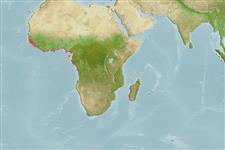Περιβάλλον / Κλίμα / Εύρος
Οικολογία
; Θαλασσινό(ά); Υφάλμυρο; εύρος βάθους 0 - 25 m (Ref. 26999). Tropical, preferred 27°C (Ref. 107945); 17°N - 7°S, 17°W - 14°E (Ref. 54448)
Africa: West African coasts and estuarine areas from Senegal to Angola (Ref. 188, 81270).
Length at first maturity / Μέγεθος / Βάρος / Age
Maturity: Lm 13.0, range 13 - 18 cm
Max length : 30.0 cm SL αρσενικό/απροσδιόριστο; (Ref. 27000); common length : 16.0 cm SL αρσενικό/απροσδιόριστο; (Ref. 188)
Εδρικές άκανθες 0; Μαλακές εδρικές ακτίνες: 45 - 50. Diagnosis: Body moderately deep, compressed, belly with 25 to 27 + 7 or 8 sharp scutes (Ref. 188, 81270). Dorsal fin at or before midpoint of body; pelvic fins small; anal fin long, with more than 40 finrays, its origin below dorsal fin base (Ref. 188). Swimbladder with two short tubes passing back in the muscles on either side of haemal spines (Ref. 188). Other clupeoid fishes in the area are more slender, have a much shorter anal fin and the lower jaw is not strongly projecting (Ref. 188).
Found in the marine environment, pelagic, along beaches and just offshore, down to about 25m; also in lagoons and estuaries, penetrating into almost freshwater (Ref. 188). It feeds on small planktonic animals, like crustaceans (Ref. 188).
Whitehead, P.J.P., 1985. FAO Species Catalogue. Vol. 7. Clupeoid fishes of the world (suborder Clupeioidei). An annotated and illustrated catalogue of the herrings, sardines, pilchards, sprats, shads, anchovies and wolf-herrings. FAO Fish. Synop. 125(7/1):1-303. Rome: FAO. (Ref. 188)
IUCN Red List Status (Ref. 115185)
CITES (Ref. 94142)
Not Evaluated
Threat to humans
Harmless
Human uses
αλιεία: Εμπορικό(ά)
Περισσότερες πληροφορίες
ΑναφορέςΥδατοκαλλιέργειεςΠροφίλ υδατοκαλλιέργειαςΣτελέχοιΓενετικήΣυχνότητες αλληλόμορφωνΚληρονομικότηταΑσθένειεςΜεταποίησηMass conversion
ΣυνεργάτεςΦωτογραφίεςStamps, CoinsΉχοιΣιγκουατέραΤαχύτηταΚολυμβητικός ΤύποςΕπιφάνεια βραγχίωνOtolithsΕγκέφαλοιΌραση
Εργαλεία
Special reports
Download XML
Διαδικτυακές πηγές
